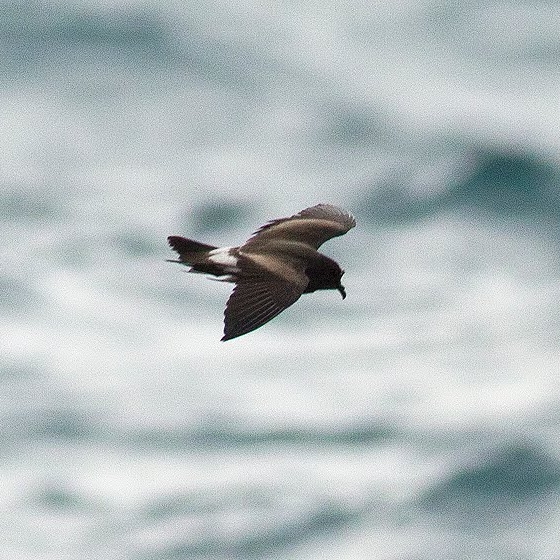Leach's Petrel
Hydrobates leucorhous (Vieillot, 1818)
TL
 LEAPE
LEAPE  550
550

Family: Procellariiformes > Hydrobatidae

This is the most marine of our breeding birds and a difficult species to see, visiting its underground nests at night and spending the rest of the time at sea.
Leach's Petrel has a more restricted breeding distribution within Britain & Ireland than the more familiar Storm Petrel, its colonies all located within 70 km of the Atlantic continental shelf. While significant numbers breed at colonies on remote islands far off the coasts of Scotland and Ireland, our population is small compared to those off North America.
As with other burrow-nesting seabirds, the species faces a threat from mammalian predators inadvertently introduced to islands. Leach's Petrels may also be taken by avian predators, which is one reason for their nocturnal habits at breeding sites.
Identification
Leach's Petrel identification is sometimes difficult. The following article may help when identifying Leach's Petrel.
Identifying Petrels

Petrels are seldom-seen, unfamiliar birds to many of us, but both species: Storm Petrel and Leach's Petrel are actually very common breeding birds and frequently encountered off our shores during passage. Both are small black and white birds that seem to defy the rough seas they are often encountered in. How can we tell the two species apart?
Develop your bird ID skills with our training courses
Our interactive online courses are a great way to develop your bird identification skills, whether you're new to the hobby or a competent birder looking to hone your abilities.
Browse training coursesStatus and Trends
Population size and trends and patterns of distribution based on BTO surveys and atlases with data collected by BTO volunteers.
CONSERVATION STATUS
This species can be found on the following statutory and conservation listings and schedules.
POPULATION CHANGE
This species nests in burrows and is difficult to survey and the first full Census was carried out during the 1998–2002 Census (Seabird 2000) using tape-playback techniques. Subsequent surveys at two UK colonies suggest that declines have occurred, included a 54% decline at the largest UK colony at Dun (St Kilda), which held around 58% of the UK population at the time of the Seabird 2000 surveys.
DISTRIBUTION
Leach's Petrel colonies are limited to remote, offshore islands in the far north and west of Scotland and Ireland, close to the deep-water areas beyond the continental shelf where they are thought to feed. Outside the breeding season they can sometimes be seen from coastal headlands and seawatching hotspots during autumn and early winter gales.
Occupied 10-km squares in UK
| No. occupied in breeding season | 9 |
| % occupied in breeding season | 0.3 |
| No. occupied in winter | 95 |
| % occupied in winter | 3.1 |
DISTRIBUTION CHANGE
Change in occupied 10-km squares in the UK
| % change in range in breeding season (1968–72 to 2008–11) | -11.1% |
| % change in range in winter (1981–84 to 2007–11) | +472.7% |
SEASONALITY
Leach's Petrel is a very localised breeder, though is rarely seen during the breeding season. Most records are in autumn and come from storm-blown individuals on the coast and occasionally inland.

Movement
Information about movement and migration based on online bird portals (e.g. BirdTrack), Ringing schemes and tracking studies.
RINGING RECOVERIES
View a summary of recoveries in the Online Ringing Report.
Foreign locations of birds ringed or recovered in Britain & Ireland

Biology
Lifecycle and body size information about Leach's Petrel, including statistics on nesting, eggs and lifespan based on BTO ringing and nest recording data.
SURVIVAL & LONGEVITY
View number ringed each year in the Online Ringing Report
Maximum Age from Ringing 
|
29 years 11 months 5 days (set in 2002) 
|
Typical Lifespan 
|
13 years with breeding typically at 5 year |
Adult Survival 
|
0.88  
|
CODES & CLASSIFICATION
Ring size 
|
B2 |
Field Codes 
|
2-letter: TL | 5-letter code: LEAPE | Euring: 550 |
For information in another language (where available) click on a linked name
Research
Interpretation and scientific publications about Leach's Petrel from BTO scientists.
CAUSES AND SOLUTIONS
Causes of change
The causes of change are unclear and the extent of the suspected decline is uncertain until the full results of the Seabirds Count (2015–2021) are published. However, predation (by Great Skuas and Great Black-backed Gulls) has been suggested as one possible cause of decline (REF FROM JNCC WEBSITE). Other factors could be contributing to decline and further investigation is needed.
Links to more studies from ConservationEvidence.com
- Measuring nocturnal seabird activity and status using acoustic recording
- An experimental study of social attraction in two species of storm-petrel by acoustic and olfactory cues
- Seabird habitat restoration on Praia Islet, Azores Archipelago
Read more studies about Leach's Petrel on Conservation Evidence >
Would you like to search for another species?











Share this page